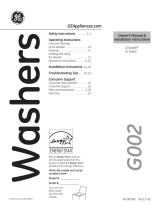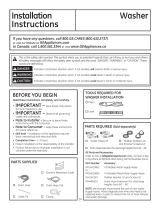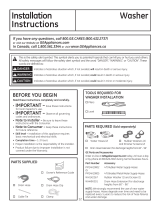
Hoses connecting washer to faucet should be
replaced every 5 years.
Water Supply Hoses
Ask the service technician to remove water from
drain pump and hoses. Do not store the washer
where it will be exposed to the weather.
Moving and Storage
Be sure water supply is shut off at faucets. Drain
all water from hoses and water filter pump area if
weather will be below freezing.
Long Vacations
Care and cleaning of the washer.
GEAppliances.com
Pour into the
washer basket
To clean the interior of the washer, select the
Basket Clean feature on the control panel. This
Basket Clean cycle should be performed, at a
minimum, once per month. This cycle will use
more water, in addition to bleach, to control
the rate at which soils and detergents may
accumulate in your washer.
NOTE: Read the instructions below completely
before starting the Basket Clean cycle.
1. Remove any garments or objects from the
washer and ensure the washer basket is
empty.
2. Open the washer lid and pour one cup or 250
ml of liquid bleach or other washing machine
cleaner into the basket.
3. Close the lid and select the Basket Clean
cycle. Push the Start button.
4. When the Basket Clean cycle is working, the
display will show the estimated cycle time
remaining. Do not interrupt the cycle.
Basket Clean may be interrupted by pressing the
Start button in between cycles. A power outage
in the house might also interrupt the cycle. When
the power supply is back, the Basket Clean cycle
resumes where it had stopped. When interrupted,
be sure to run a complete Basket Clean cycle
before using the washer. If the Power button is
pressed during Basket Clean, the cycle will be
lost.
IMPORTANT:
Run Basket Clean with 1 Cup (250 ml) of
bleach once a month.
After the completion of a Basket Clean cycle,
the interior of your washer may have a bleach
smell.
11
Cleaning the Dispenser Drawer
After some period of use, a small amount of
detergent or softener residue may be present in
the dispenser drawer. The drawer can easily be
removed for cleaning. To remove the drawer, pull
it out until the drawer stops and then lift up on
the front of the drawer. The drawer can then be
removed from the dispenser box. Wash the drawer
in warm, soapy water using a mild detergent.
Rinse drawer with warm water. If siphon caps are
removed for cleaning, be sure to push siphon caps
fully back into place after cleaning.
The dispenser drawer and siphon caps are
not dishwasher safe. The dispenser box is not
removable, but it can be wiped clean using a
damp cloth if necessary. Do not attempt to
remove the dispenser box for cleaning.
Immediately wipe off any spills with a damp cloth.
Exterior of the Washer
Your washer is equipped with Consumer Help Indicator (CHI). CHI is our way to communicate a simple remedy for some situations that
you can perform without the need to call for service. The chart below describes the helpful messages you may notice scrolling on your
display when you return to start another load. These messages will provide simple remedies you can quickly perform.
To ensure that you see the message, the washer will scroll the message continually until you interact in some way with the controls.
“bALAnCIN
g
” After the wash cycle, the clothing wasn’t evenly distributed enough to spin out the water. Redistribute the clothes
more evenly in the washer and then run a Drain & Spin cycle.
“Po” (Water took
too long to Pump
Out)
Resume cycle or enter Drain & Spin. If water pumps out, then the clog has likely cleared. If water remains in the
washer, check for clogged or pinched drain hose. This situation could be more likely to appear, over time, if the
external drain hose has been extended or restricted.
“H2O SUPPLY”
(Water not
entering washer)
Check your house water supply. Did you forget to turn on one or both supply valves after installation or coming
back from vacation? As soon as the message starts to scroll, the washer will initiate a 3 minute lock-out period. The
washer controls won’t respond/change during this time. After the 3 minutes, you can begin your cycle again. If you
try to bypass the lock-out period by unplugging the washer, the 3 minute timer will start over again.
“CAnCELEd” If your machine has stopped itself before the cycle completed, CAnCELEd will scroll in the display. On models without
a display, the two furthest right LED lights will flash. This indicates that an error has occurred. Try to run a Drain &
Spin cycle to see if it will clear. If it does not clear, call 800.GE.CARES (800.432.2737) for service.
Interior of the Washer
Consumer Help Indicator























